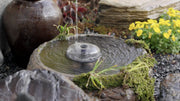
Introduction: Why Build A Patio Pond?
Picture stepping onto your balcony on a warm evening: instead of plain decking boards, you meet the gentle scent of water lilies, the mirror-bright glint of a floating fountain, and the soft clap of tiny waves against a rustic cedar barrel. A tiny dragonfly skims the surface, and two inquisitive goldfish rise like living jewels for a pinch of food. That micro-oasis is a patio pond—no shovel, no wiring trench, just a container, sunshine, and a few smart accessories.

In an urban world where outdoor space is measured in square feet and electricity outlets are at a premium, a Poposoap-powered deck pond offers a rare blend of nature and simplicity. Because Poposoap’s solar fountains, filters and lights sip only daylight, you can drop them into a whiskey barrel or ceramic bowl and have ready-made circulation and sparkle without a single kilowatt on the meter. Better still, the setup is as therapeutic as the finished water-garden: selecting the vessel, arranging plants, hearing that first burble of water, all turn into a mindfulness ritual—one that keeps paying dividends through every season.
Add to that the ecological boost—fresh water for pollinators, mosquito control via surface motion, and an instant classroom for kids fascinated by tadpoles—and it’s clear why so many gardeners now treat a pond patio feature as the centrepiece of outdoor living. Let’s walk through the build, Poposoap style, so you can swap concrete glare for rippling reflections by this weekend.
Choose The Right Container
Your “pond” can be anything watertight and weather-resistant:
- Half-whiskey barrel (lined with a flexible pond liner or pre-formed insert).
- Glazed ceramic bowl—adds colour and stands up to UV.
- Stock-tank trough—sturdy galvanised steel for modern patios.
- Large resin planter—lightweight for balconies.
Look for at least 40–60 gallons (150–225 L) and 35 cm (14 in) depth. That volume keeps water temperature stable and gives plant roots room to breathe.
Set It Up: The Poposoap Way
Step 1 – Seal or Line the Vessel
Scrub the container clean. If it’s wood or metal, slip in a flexible EPDM or PVC liner so tannins or rust never reach the water. Ceramic and resin vessels can hold water as-is after a rinse.
Step 2 – Add a Poposoap Floating Solar Fountain
Drop the pump in, let the attached solar panel catch light, and you instantly have surface movement, aeration, and a sparkling spray that deters mosquito larvae. There’s no wiring, no outlet, and no risk if rain splashes the cord—Poposoap designs its solar fountains with IP68-rated housings and generous lead cables so the panel stakes neatly into the nearest sunny flowerbox.
Step 3 – Introduce Aquatic Plants
Line the base with a thin layer of rinsed pea gravel to weigh down pond baskets. Set dwarf water lilies on a brick so leaves will float just below the rim. Tuck marginal plants—like miniature cattail or dwarf papyrus—into mesh pots around the edges. Gravel on top stops fish (or visiting birds) from uprooting them.
Fill slowly with dechlorinated tap or rainwater, let the solar fountain circulate for an hour to clear dust, and you’re ready to add wildlife.
Smart Plant Choices
- Dwarf Water Lily (Nymphaea ‘Pygmaea Helvola’) – tiny pads and lemon-yellow blooms suit shallow vessels.
- Water Hyacinth or Water Lettuce – floaters that shade water, soak up nitrates, and provide spawning mats for insects.
- Creeping Jenny – trails down the outer wall, hiding the liner lip and softening hard edges.
- Parrot’s Feather – delicate feathery stems break the waterline, adding height and excellent micro-filtration.
Avoid rampant spreaders such as duckweed unless you enjoy weekly skimming.
Maintenance Tips—Minimal With Poposoap
Solar simplicity: Poposoap’s floating fountain runs when the sun shines—the exact time oxygen demand peaks—then rests at night, saving wear on the motor. If you choose the model with a small lithium reserve, spray height stays steady through light cloud.
Monthly sponge rinse: Slip the fountain’s intake sponge off and swish it in pond water; five minutes keeps flow strong.
Top-ups, not water-changes: Patio ponds lose water by evaporation. Add fresh (dechlorinated) water every week until the rim sits 2–3 cm below the lip. Full water changes are rarely needed unless debris or runoff contaminates the bowl.
Balanced feeding: If you keep two or three comet goldfish, feed them what they finish in two minutes once a day. Excess pellets rot, clouding water and clogging the fountain nozzle.
Common Issues Solved
Green water bloom? Shade at least half the surface with floaters; position the solar panel in full sun but angle the vessel so direct midday rays hit water for no more than six hours. Poposoap fountains create surface ripple that helps disperse microscopic algae before it swirls into dense clouds.
Mosquito larvae despite movement? Add a capful of mosquito-dunk bacteria or introduce a trio of white-cloud minnows—tiny fish that thrive in patio ponds and devour wigglers.
Pump clogging with plant roots? Slip a foam pre-filter block (Poposoap stocks replacements) over the intake and trim floating roots every fortnight.
Winter freeze worries? In mild climates, simply remove the fountain, drain 25 % of water to allow for ice expansion, and cover the pond with a framed sheet of clear polycarbonate to keep debris out.
Conclusion: Nature + Simplicity = Poposoap
Building a pond in patio spaces or on an apartment deck doesn’t need hired contractors or high-voltage pumps. Seal a beautiful vessel, let Poposoap’s floating solar fountain supply oxygen and sparkle, and choose plants that do the heavy lifting on water clarity. The result is a living centrepiece that cools the air, soothes the mind, and invites butterflies—without a single kilowatt from the grid.
Whether you call it a deck pond, a balcony bowl, or a pocket water-garden, the recipe is the same: sun-powered circulation, thoughtfully chosen plants, and minimal-effort upkeep. In just one afternoon, you’ll transform a quiet corner of paving into a micro-ecosystem—proof that nature thrives anywhere simplicity and smart design meet.







